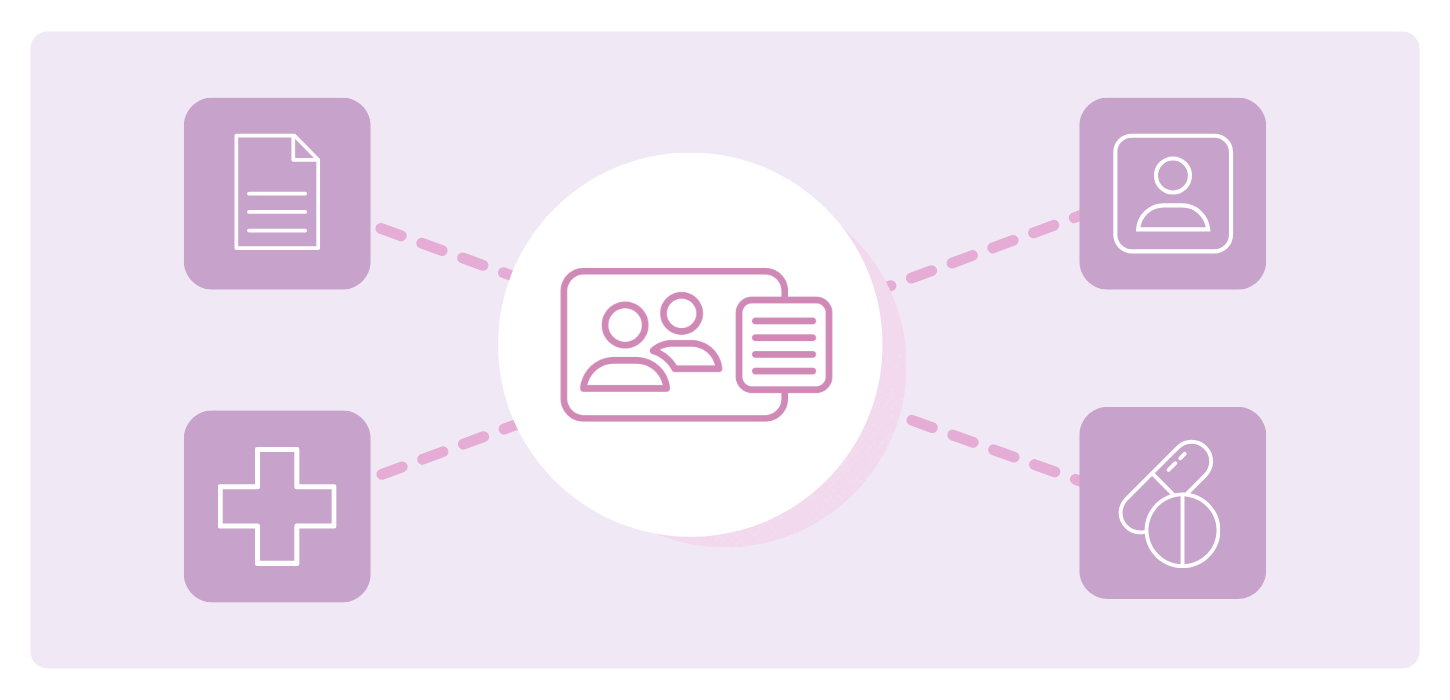At A Glance
Identity resolution unifies fragmented IDs into complete customer profiles, helping companies understand their audiences and deliver personalized, privacy-compliant experiences in a cookie-light world. With Experian’s AI-powered identity resolution solution, marketers gain the scale, accuracy, and compliance to compete while making marketing more human.In this article…
Every marketer has seen it: a customer browses reviews on a laptop, adds items to a cart on mobile, then “disappears.” In reality, they just likely switched devices or logged in with a different email. Identity resolution connects these scattered signals into a single profile so you never lose sight of the customer journey.
Identity resolution is what helps you keep track of customers who bounce around.
Connecting scattered signals into a single customer profile can help you deliver seamless experiences, meet strengthening privacy standards, turn first-party data into measurable results, and fuel better customer analytics.
See our identity resolution solution in action
What is identity resolution?
Identity resolution is the process of pulling together the different identifiers a customer uses and connecting them to a single profile. Without it, you’re left with an incomplete picture of the customer — like a cart tied to one email, an app login tied to another device, or a loyalty swipe that never links back to the same person.

Common identifiers include:
- Cookies: Short-lived browser data
- Emails: Plain-text and hashed
- Device IDs: Mobile advertising IDs (MAIDs) or app-based identifiers
- Loyalty IDs: Program numbers that tie online and offline activity
- Hashed PII: Personally identifiable information (PII) encrypted for privacy
Ultimately, identity resolution can help you recognize the same customer wherever they engage.
Why does identity resolution matter now?
Marketers face incomplete views, data silos, privacy regulations, and shrinking visibility:
- Rising consumer expectations: People want seamless, personalized journeys across touchpoints.
- Privacy-first environment: Consumer privacy legislation (like the GDPR, CCPA, GLBA, FCRA, and new state laws) makes compliance non-negotiable.
- Signal loss: The decline of cookies, MAIDs, and walled gardens are pushing brands toward first-party data.
Experian utilizes AI and machine learning to fill these gaps, predict behaviors, and connect signals across devices — providing marketers with a clear, privacy-safe view of their customers, even when traditional identifiers are missing.
In this environment, identity resolution matters because it gives marketers a way to deliver seamless, personalized customer experiences and engage audiences effectively while respecting their privacy. It’s the basis for turning consented first-party data into measurable marketing outcomes without sacrificing trust.
Why is identity resolution critical in a privacy-first world?
Even as cookies linger, marketers have already shifted their strategies to rely on first-party data, where choice and transparency are the baseline expectation. At Experian, our long history as a regulated data steward makes us a uniquely capable and trusted partner for managing modern compliance expectations. Our identity resolution solutions maximize the value of permission-based data while meeting consumer demand for privacy, personalization, and control.
Struggling with scattered customer data? Experian makes identity resolution seamless
How does identity resolution help brands?
Identity resolution turns fragmented signals into unified profiles that drive personalization, efficiency, and compliance. Here’s how it creates measurable business impact.
Creates a unified customer view
One of the biggest advantages of identity resolution is the ability to integrate data from loyalty programs, point-of-sale (POS) systems, customer relationship management (CRM) platforms, web analytics, and offline sources into a single, comprehensive profile. Experian strengthens identity resolution with AI-driven clustering models that resolve household and individual identities across billions of signals with greater accuracy.

With a clearer picture of each customer, brands see higher match rates and larger addressable audiences, which translates to more substantial reach and better return on ad spend (ROAS).
Enables better personalization
Customers constantly switch devices, update their information, and change preferences. Experian makes it easier to keep pace with these changes through frequent data enrichment and near-real-time identity resolution via Activity Feed.
Combined with our long-standing use of AI and machine learning, this approach ensures shifting behaviors are captured quickly, enabling timely personalization, and more responsive engagement.

With less delay from data to action, the result is faster response times and higher conversion rates.
Improves the customer experience
Customers notice when brands deliver relevant ads and contextual content across every channel. Consistency matters! But consistency doesn’t just happen on its own; it comes from identity resolution, which keeps the customer journey connected.

As brands maintain continuity, they build trust, strengthen engagement, and increase customer lifetime value.
Drives better marketing ROI
Not every profile is valuable. Identity resolution helps marketers identify the highest-value audiences and reduce wasted spend.

That efficiency leads to lower CPA and a higher overall ROI across campaigns.
The power of modeling from a stronger foundation
When you have a unified customer view, your models are built on better data. That means you can find more people who look like your best customers, build more responsive audience segments, and target with greater accuracy. This foundation can lead to better spending, more relevant campaigns, and a higher ROI.
Maintains privacy compliance
With GLBA/FCRA-grade standards and consumer choice mechanisms like opt-outs and data correction, you can protect your brand while maintaining personalization — without compromising legal or ethical safeguards.

What are some identity resolution use cases and examples?
Every industry faces its own unique identity challenges, but identity resolution is the common thread that turns scattered data into connected experiences. Let’s break down how companies in different verticals are putting it to work (and the kinds of results they’re seeing).
Retail and e-commerce
Shoppers bounce between websites, carts, and checkout lines, leaving behind scattered signals in the process. In retail, identity resolution bridges the gap between online and in-store experiences by matching online carts with loyalty swipes or connecting connected TV (CTV) exposure to in-store sales. This means fewer silos, better targeting, and more personalized offers wherever people shop.

Our 2025 Digital trends and predictions report calls out that omnichannel experiences aren’t optional anymore. With CTV and social dominating spend, brands need identity resolution to cut through silos and build a complete view of customer behavior.
Financial services
In financial services, identity resolution makes it possible to deliver personalized, compliant offers like refinancing options for likely mortgage switchers or the right rewards card for frequent spenders.
Our partnership with FMCG Direct to create Consumer Financial Insights® and Financial Personalities® segments helps banks, insurers, and lenders understand behaviors — such as credit card use, deposit balances, and investment habits — without exposing sensitive details.
Read more below about how our financial audiences enable privacy-safe personalization.
Travel and hospitality
Travel decisions aren’t always planned out in advance. Many bookings happen spur-of-the-moment, which is why real-time identity resolution is so powerful; it keeps the journey seamless when travelers jump from phone to laptop to tablet and presents relevant offers right as decisions are being made.
Windstar Cruises put this information into action with Experian’s identity graph to connect digital interactions with actual bookings, which drove 6,500+ reservations and $20 million in revenue.
Media and TV
Viewers tend to hop around between linear TV, streaming apps, and social feeds. And without identity resolution, every screen looks like a different person. Marketers can accurately plan, activate, and measure campaigns by unifying viewing behaviors into one ID with Experian’s AI-powered identity graph.

Optimum Media tackled its multiscreen challenge by partnering with Experian for identity solutions. Layering our audience insights and our AI-driven Digital Graph onto their subscriber data, they were able to connect the dots across channels, reach the right households, and measure results instead of just impressions. In the end, they finally got a clear view of what works across every screen.
Curious how identity resolution can power your customer analytics? We can walk you through it.
Healthcare and pharma
Healthcare marketers can’t afford slip-ups with HIPAA regulations. Identity resolution makes it possible to engage the right patients and providers with de-identified audiences rather than third-party cookies.

At Experian, AI and machine learning have always been part of how we power identity resolution. In healthcare, that means using AI-enhanced modeling to connect de-identified clinical and claims data with lifestyle insights. The result is a more comprehensive picture of the patient journey that helps close care gaps, reduce wasted spending, and improve outcomes.
By working with partners like Komodo, PurpleLab, and Health Union, we make it possible to activate campaigns at scale that boost engagement and adherence while keeping patient privacy front and center:
- Komodo Health enriches our identity graph with insights from millions of de-identified patient journeys plus lifestyle data, giving brands a fuller view of where care gaps exist and how to close them.
- PurpleLab connects real-world clinical and claims data to Experian’s platform, letting advertisers activate HIPAA-compliant audiences across CTV, mobile, and social with the ability to measure real outcomes like prescription lift and provider engagement.
- Health Union contributes a data set built from 50 million+ patient IDs and 44 billion+ patient-reported data points. Combined with our identity and modeling capabilities, this expands match rates and unlocks up to 76% net-new reach, so campaigns reach patients and caregivers in critical health moments.
As a result, healthcare brands can launch campaigns that are privacy-first, highly targeted, and proven to drive meaningful impact.
Audio
People use audio while commuting, working out, and even folding laundry. It can be one of the hardest channels to track because of how frequently listeners switch between apps, stations, and devices.

Experian’s identity resolution partnerships with Audacy and DAX change the game:
- Audacy helps tie scattered listening into a single view, so advertisers can follow audiences across devices and keep ads relevant in the moment.
- DAX pairs Experian’s 2,400+ syndicated audiences with its audio network, enabling brands to target precisely and launch impactful campaigns at scale.
These partnerships turn audio into an accurate channel where ads feel personal, privacy-safe, and measurable.
Gaming
Gamers don’t stick to one platform. Player data gets scattered across mobile, console, and PC, so it’s tough to keep track of individuals. Experian helps stitch those signals together so publishers can finally see the whole picture, personalize gameplay, and keep players coming back.
With enriched profiles, publishers can deliver offers that resonate and unlock fresh revenue by packaging high-value gaming audiences for advertisers outside the industry.
Unity, a leading gaming platform, is tapping into Experian’s syndicated audiences to gain player insights and help advertisers reach gamers across mobile, web, and CTV. For global publishers, unifying player data with Experian has driven higher engagement and stronger ad ROI.
How should I evaluate identity resolution providers?
When choosing an identity resolution partner, look for:
- Data scale and quality: The value of identity resolution depends on how complete and accurate the underlying data is. The right provider should bring together a wide range of identifiers from online and offline sources, maintaining high accuracy so your customer profiles are broad and reliable.
- Match accuracy and recency: The best partners also refresh their data regularly and can blend deterministic (exact, one-to-one matches) with probabilistic (pattern-based matches) methods. That way, you get the accuracy of “this email is definitely that customer” with the reach of “this device likely belongs to the same person.”
- Privacy and compliance readiness: Compliance can’t be an afterthought. Your identity partner should be ready for GLBA, FCRA, GDPR, CCPA, and the latest state-level rules with built-in tools for opt-outs, corrections, and deletions.
- Integration flexibility: A good provider fits into your world, not the other way around. Look for pre-built integrations with your customer data platform (CDP), demand-side platform (DSP), or marketing tech (MarTech) stack so you can get up and running without the heavy IT lift.
- Data analytics capabilities: You need proof that identity resolution drives ROI. Look for closed-loop measurement that ties unified IDs directly to campaign performance, so you can see what’s working and optimize with confidence.
How Experian enables enterprise-grade identity resolution
Experian delivers identity resolution at the scale, accuracy, and compliance required by the world’s largest enterprises. Our solutions are:
- Built on trust: Backed by 40+ years as a regulated data steward and rated #1 in data accuracy by Truthset, so you can act with confidence.
- Powered by our proprietary AI-enhanced identity graph: Combining breadth, accuracy, and recency across four billion identifiers, continuously refined by machine learning for maximum accuracy.
- Seamlessly connected: Pre-built data integration with leading CDPs, DSPs, and MarTech platforms for faster time to value.
- Always up to date: Frequent enrichment and near-real-time identity resolution through Activity Feed for timely personalization and more responsive customer engagement.
- Privacy-first by design: Compliance with GLBA, FCRA, and emerging state regulations baked in at every step, supported by rigorous partner vetting.
The bottom line
Identity resolution turns fragmented signals into connected, measurable, and compliant experiences. From retail to gaming, brands using it see stronger personalization, engagement, and ROI.
With Experian, you get the data, trust, and responsible AI innovation to make identity resolution work across every channel. Our approach uses AI to connect identities, predict behaviors, and deliver personalization that balances privacy with performance. If you’re ready to turn fragmented data into growth, now’s the time to start.
The world’s leading brands trust us to power identity resolution at scale. See how we can do the same for you.
Identity resolution FAQs
Deterministic uses exact identifiers (like an email) for accuracy, while probabilistic uses signals and algorithms to expand reach. Best-in-class providers usually combine both.
Identity resolution helps with personalization by unifying scattered signals into one profile. It reduces wasted spend and increases match rates, which means bigger addressable audiences and higher ROAS.
Yes. With first-party data and hashed PII, brands can still maintain addressability and personalization.
Retail, finance, travel, media, gaming, and audio all use identity resolution to personalize, attribute sales, and improve efficiency.
A customer data platform unifies the data you already own. Meanwhile, we add depth, scale, and higher match rates by layering in our identity graph and data enrichment.
Yes. Experian is GLBA/FCRA compliant, GDPR/CCPA ready, and supports consumer opt-outs and corrections to ensure responsible personalization.
Latest posts

As I walked onto the buzzing streets of Cannes for the first time, my senses were immediately captivated by the energy that filled the air. I'd heard plenty about Cannes Lions, the globally revered International Festival of Creativity, but being in the midst of it all was an entirely different ballgame. 1. A visual extravaganza From the moment I woke up from my two-hour nap, (Seattle was a long way to travel to Cannes), I was awestruck by the grandeur of the festival. Usually known for its tranquil beauty, the city was alive and brimming with imagination. Massive installations, eye-catching billboards, and immersive media experiences were scattered over the two-kilometer stretch of La Croisette, transforming the city into a canvas of creativity. I saw firsthand how abstract concepts could be turned into palpable realities, especially those of Spotify, Yahoo!, and Stagwell's Sport Beach with their basketball court with stadium seating setup. 2. Nuggets of wisdom shared in panels The festival's days were jam-packed with thought leadership panels – each a masterclass in the ever-evolving universe of AdTech. Fortunately, as a member of the Experian team, I didn't have to travel far for unique panels; we hosted four panels throughout the week, and I was immersed in dynamic discussions about new trends, groundbreaking ideas, and the challenges ahead. One recurring theme that resonated with me was the intricacies of authentically connecting with consumers. Finding genuine human connections amidst digital chaos can be challenging in today's tech-driven world. These dialogues provided incredible insights into how we could maintain the delicate balance between personalization and privacy and effectively use artificial intelligence (AI) to enhance customer engagement without compromising the human essence in advertising. Watch our panels 3. Connect with your peers If Cannes Lions is known for anything apart from its creative inspiration, it's the unparalleled networking opportunities. The festival allowed me to interact with professionals from all corners of the world. Each exchange was not merely about exchanging contact details but building meaningful relationships. Will these first arcs lead to meaningful friendships? I sure hope so. 4. A comprehensive learning opportunity The most crucial aspect of the festival was the immense opportunity it offered for learning. I found myself constantly absorbing new information and insights from the panels, every conversation, and every chance meeting. 5. Juggle your time Effective time management was crucial for maximizing my Cannes experience, with many things happening concurrently. I would give myself a B- for this. During the day, when I had some downtime, I could have ventured to another panel, attended a networking event, or taken in a view of the city I didn't get. That's the biggest challenge, and the beauty of Cannes Lions is its unique blend of professional learning opportunities set against the backdrop of a picturesque seaside town, but how do you do it all? 6. Relish the experience My week at Cannes was filled with intense learning, insightful conversations, and eye-opening experiences, leaving me mentally drained and intellectually stimulated (I think those can happen concurrently). The festival left me with a renewed appreciation of why we do what we do in the AdTech industry: supporting the pursuit of creativity, the drive for innovation, and the desire to forge meaningful connections. Cannes Lions was more than just a festival – it was a week of stepping out of my comfort zone, gaining deep insights, and establishing relationships that I hope will last a lifetime. As I boarded my flight out of Nice, surrounded by adults with layers of event access bracelets, I was inspired and stacked with knowledge and ideas that will help drive meaningful marketing opportunities with our content and partnerships. The grandeur, the learning sessions, the networking, and the profound lessons exceeded all my expectations. My week at Cannes Lions was unique, intense, insightful, and unforgettable. It was an experience I can't wait to repeat! Follow us on LinkedIn or sign up for our email newsletter for more informative content on the latest industry insights and data-driven marketing. Get in touch Latest posts

It’s been one week since the highly anticipated Cannes Lions 2023 – the event of the year for advertising and creativity. We're thrilled to share our top four key takeaways from the event, showcasing what the industry will prioritize in the upcoming year. Signal loss At Cannes Lions 2023, experts underlined the detrimental effects of signal loss on advertising and emphasized the significance of having diverse channels. Discussions emphasized the importance of adapting paid media strategies to align with evolving consumer behaviors in order to remain relevant in the ever-changing landscape. Urgency in planning and avoiding being caught without a solid strategy was a common theme throughout the event. Alternative identifiers, like first-party data, were highlighted, as they prioritize privacy-centric approaches. Contextual advertising emerged as a key part of the solution, providing relevant ads that fit seamlessly into the user's experience. Collaboration Collaboration was a major theme at Cannes Lions 2023. Attendees explored topics such as maintaining privacy and identifying the right attributes for effective targeting. Clean rooms were discussed as a way to ensure privacy when sharing data, and highlighted partnerships as the key to unlocking interoperability within the advertising ecosystem. The discussions underscored the need for industry players to join forces and collaborate on solutions that benefit all stakeholders in the ecosystem. “What makes Cannes unique is that you have a lot of decision makers in the room at the same time. This leads to more efficiency in terms of coming up with goals and objectives and really getting to the heart of the key aspects for us to build partnerships.”alison omealia, vp, customer success, experian Personalization Personalization was a key topic of discussion at Cannes Lions 2023, with its growing significance in advertising taking center stage. The event emphasized the need to focus on serving up tailored content that resonates with individual consumers, cultivating brand affinity. The intersection of science and art was highlighted, emphasizing the role of data-driven insights and creativity in supporting frequency capping and delivering engaging content. Advertisers are adapting to cookie deprecation by shifting from cookie-based third-party targeting to first-party data solutions. This is due to the significant changes in the consumer privacy landscape, which have limited advertisers' access to signals emitted by consumers through their devices and browsers. As a result, alternative IDs like UID2, Ramp ID, and ID5 are emerging as viable options for advertisers to continue personalized targeting. Balancing AI and creativity at Cannes Lions 2023 Participants shared invaluable insights on how to strike the right balance between harnessing AI's capabilities and nurturing creativity to keep the human touch alive. The event emphasized the importance of understanding the boundaries of AI while utilizing tools that drive innovation and imagination. Attendees explored the dynamic roles that AI provides and discussed how it can help push the boundaries of their creativity while still keeping the human element intact. As technology continues to advance, so does the need for advertisers to adapt their approach and integrate AI in a way that enhances their creative output. Experian events at Cannes Lions 2023 We hosted a series of events that included a kick-off event and four panels. The activities were designed to provide attendees with valuable insights on various topics related to advertising and data privacy. Here's a recap of what we covered during the week. Experian’s Cannes Lions kick-off event We co-hosted a kick-off event on Sunday with Audigent. It was a successful event that brought people together to launch an important week in the AdTech industry and build connections with clients and prospects alike. Data on the sell-side Ongoing signal loss has marketers, agencies, and platforms tapping directly into the sell-side for high-quality audience and context. In this panel, industry experts from Truthset, Captify, Audigent, Newsweek, and PubMatic joined Experian to discuss the imminent disappearance of cookies and the need to adapt and future-proof data privacy strategies. The deprecation of third-party cookies presents an incredible opportunity to redefine data privacy practices and empower consumers. Our panelists emphasized the need to adapt and invest in alternative identifiers in order to thrive in a cookie-less future. Publishers were urged to create valuable content, engage in first-party activities, and consider the next generation of consumers who are growing up without traditional identifiers. The fragmented landscape calls for a variety of tactics and partnerships, while AI can provide opportunities to explore beyond deterministic identifiers, fostering creativity and innovation in advertising practices. Stacking the marketer's toolbox for success In partnership with Adweek Abroad in Cannes, industry leaders from FreeWheel, Tubi, and Instacart joined Experian to discuss opportunities for brands to unlock deeper, richer, and more scalable insights into current and potential customers. The panelists highlighted several key considerations, including building a robust first-party data strategy, ensuring accuracy in data quality partnerships, and establishing better-connected communications and relationships with consumers. Participants acknowledged the value of consumer data and urged advertisers to remain purpose-driven, always putting the viewer first. The freshness and recency of data were identified as critical factors for establishing quality connections with consumers and staying attuned to consumer trends. What does the future of identity hold? During this panel discussion, industry leaders from the IAB, MiQ, Cint, Direct Digital Holdings, and Tatari joined Experian to explore the future of identity. The panelists discussed the challenges cookie deprecation poses in programmatic advertising and the need for new identifiers and solutions. They also acknowledged the expanding media landscape and the importance of frequency capping and attribution measurement in a post-cookie era. Trends to watch for include the potential consolidation of identifiers and the movement of first-party data in-house by larger media companies. Panelists shared different views on cookie deprecation readiness and the overhype of AI in the industry. Streaming takes center stage OMG, Roku, AMC Networks, Paramount, and Disney joined Experian to discuss streaming TV as a fragmented and evolving landscape. The panelists debated whether it has become a performance channel and emphasized the need for client education, attribution, and optimizing performance metrics. They also discussed reaching audiences across different mediums with data interoperability, audience targeting, and reliable identity solutions. The panelists explored the emerging trend of AI, optimizing ad placement, refining targeting, streamlining creative approval, and enhancing ad breaks. “A lot of trends in AdTech are relevant to TV, but the most consistent trend has definitely been having a solid identity source throughout the whole lifecycle of a campaign within TV.”ali mack, sr. director, platforms, experian Watch our panels Let’s keep the conversation going The innovation and possibilities for signal loss, collaboration, personalization, and balancing AI and creativity are limitless, but understanding exactly how to get there is what can make all the difference. As we wrap up another successful week at Cannes Lions, let's use these conversations as an opportunity to advance together toward a more connected future — what trends are you most looking forward to? If you’d like to discuss any of these topics further, get in touch with us! Check out more Cannes content: Insights from a first-time attendee Four new marketing strategies for 2023 Exploring the opportunities in streaming TV advertising The future of identity in cookieless advertising Maximize ad targeting with supply-side advertising Follow us on LinkedIn or sign up for our email newsletter for more informative content on the latest industry insights and data-driven marketing. Get in touch Latest posts

Based on the Q1 U.S. Travel Association Consumer Quarterly Tracker conducted by Ipsos, 52% of American adults are eagerly planning to embark on leisure travel within the next six months. With the pandemic limiting travel opportunities for so long, people are more willing than ever to prioritize travel and make up for lost time. With the summer vacation season upon us, it's crucial to identify consumers who are eager to travel and implement a targeted travel advertising strategy. To help you stand out in the competitive marketplace, we’ll share five audiences you should consider when building out your summer travel advertising activation plan. What separates Experian's syndicated audiences Experian’s 2,400+ syndicated audiences are available directly on over 30 leading television, social, programmatic advertising platforms, and directly within Audigent for activation within private marketplaces (PMPs). Reach consumers based on who they are, where they live, and their household makeup. Experian ranked #1 in accuracy by Truthset for key demographic attributes. Access to unique audiences through Experian’s Partner Audiences available on Experian’s data marketplace, within Audigent for activation in PMPs and directly on platforms like DirectTV, Dish, Magnite, OpenAP, and The Trade Desk. Five travel advertising audience categories With so many travel audiences out there, it can be overwhelming to figure out which ones to target. That's why we've compiled a list of the top five audience categories you should focus on: Seasonal spenders Frequent travelers Travel transportation methods Luxury travelers Vacation type Let's break down each category so you can better understand the travel behaviors and preferences of each group. Seasonal spenders These travelers are known for their willingness to spend during peak travel seasons. They're willing to spend more for travel experiences and have a high propensity to travel. Let's take a look at a few audience segments included in this category that you can activate as part of your summer travel advertising strategy. Retail Shoppers: Purchase Based > Travel > Vacation/Leisure Travelers: Summer Trips: Consumers in this segment are frequent, high spenders of summer travel. Mobile Location Models > Visits > Summer Break Travelers: Consumers in this segment are likely to travel during summer break. Retail Shoppers: Purchase Based With Experian's Retail Shoppers: Purchase Based audiences, you can reach consumers who have a high propensity to buy in specific categories like toys, furniture, apparel, and more. This audience is created by combining known credit and debit transactions with advanced modeling to ensure the highest likelihood of future purchases. You can use these audiences to find travelers interested in the outdoors that spend their money on related gear and activities, or travelers who use rental cars throughout their trip. Mobile Location Models Our Mobile Location Models are based on a statistical analysis of mobile location data from devices. The model is built from individual, household, and area-level Experian Marketing Data. You can use these audiences to find travelers that like to visit theme parks, travel during the July 4th holiday, and travel during summer break. Frequent travelers Consumers in this audience category prioritize travel as a lifestyle choice and they're always looking for their next adventure. They're willing to spend money to make their travel dreams come true and often participate in loyalty programs to earn rewards. Here are just a few examples of the audience segments you can activate to target frequent travelers as part of your travel advertising strategy: Lifestyle and Interests (Affinity) > Travel > Frequent Flyer Program Member: Consumers in this segment are likely to be members of frequent flyer programs. Retail Shoppers > Purchase Based > Travel > Hotels > Frequent Spend: Consumers in this segment frequently spend at hotels like Holiday Inn, Hyatt, Marriott, and Wyndham. Lifestyle and Interests Experian’s Lifestyle and Interests audience segments make it easy to identify and target consumers based on their lifestyle characteristics. These audiences cover a wide array of lifestyle categories, such as: Activities/Interests Purchasing Behavior Contributors/Memberships Lifestyle/General You can use these audiences to find travelers that enjoy boating, like to visit zoos, and are fishing enthusiasts. Travel transportation methods This audience category consists of the transportation methods travelers use to reach their destination or use throughout their travel experience. Here are just a few examples of the audience segments you can activate to target travelers based on their preferred mode of transportation as part of your travel advertising strategy: Autos, Cars, and Trucks > Vehicle Lifestyle Ownership > Recreational Vehicle (RV) Travelers: Consumers in this segment are likely to currently own an RV and use it for travel. Lifestyle and Interests (Affinity) > Travelers > Air Travel (FLA / Fair Lending Friendly): Consumers in this segment are interested in traveling by plane based on their internet activity in the last 90 days. Luxury travelers These high-end travelers seek exclusive, high-end experiences, from top-tier dining to luxurious accommodations. Here are just a few examples of the audience segments you can activate to target luxury travelers as part of your travel advertising strategy: Consumer Financial Insights > Discretionary Spend – Travel > $10,000+: Consumers in this segment are likely to spend more than $10,000 for travel. Retail Shoppers: Purchase Based > Travel > Hotels: Luxury: Consumers in this segment are frequent, high spenders at high-end hotels like Renaissance Hotels, Westin, and Hilton Hotels. Vacation type Unlike the previous categories, our vacation type category focuses on the type of trip a traveler is planning and the destination they're heading to. Whether it's a beach getaway or an adventure-filled trip, segments within this category can help you target consumers looking for those particular experiences. Here are just a few examples of the audience segments you can activate to target travelers by vacation type as part of your travel advertising strategy: Retail Shoppers: Purchase Based > Travel > National Park Travelers: Consumers in this segment are likely to travel to national parks. Travel Intent > Activities > Winery Distillery Brewery Tours: Consumers in this segment are likely to visit wineries, distilleries, and breweries while traveling. Family size and structure In addition to our five recommended summer travel advertising audience categories, it's important to add audiences related to family size and structure to your targeting strategy for the summer travel season. Families with children, for example, are a significant market for summer travel, as parents are looking to create memories with their kids before they go back to school. Families with children have distinct needs and preferences when it comes to travel. For instance, they may need larger accommodation options, kid-friendly activities, and safe environments. On the other hand, married couples with no children or single travelers may have different preferences for their travel experiences. These groups may be looking for more adventurous or adult-oriented experiences, such as camping, hiking in national parks, or winery tours. By segmenting your audience based on family size and structure, you can provide more relevant and personalized recommendations to your target audience, leading to higher engagement and conversion rates. Here are just a few examples of the audience segments you can activate to target travelers based on their family size and structure as part of your travel advertising strategy: Demographics > Marital Status > Single: Consumers in this segment are likely to be single. Lifestyle and Interests (Affinity) > Moms, Parents, Families > Married Mothers: Consumers in this segment are likely to be married females with at least one child under the age of 18 years old. Demographics > Presence of Children > Ages: 0-18: Consumers in this segment are likely to have children between the ages 0 to 18 years old in a household. Demographics > Presence of Children > Ages: 7-9: Consumers in this segment are likely to have children between the ages 7 to 9 years old in a household. We can help you reach summer travelers From seasonal spenders to luxury travelers, there are a host of audiences you should keep in mind as you build out your summer travel advertising strategy. Experian audiences can help you tap into the potential of your summer campaigns by enabling you to identify, reach, and engage with a variety of travelers in their preferred channels. Need a custom audience? Reach out to our audience team and we can help you build and activate an Experian audience on the platform of your choice. Additionally, work with Experian’s network of data providers to build audiences and send to an Audigent PMP for activation. Contact us Latest posts